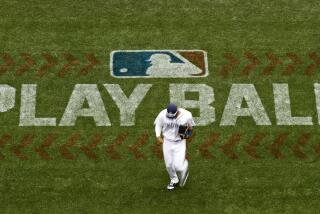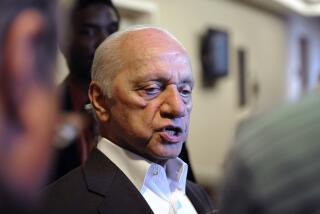Marlin Perkings
MIAMI — Mike Lowell, the Florida Marlin third baseman, can be sure about one thing in tonight’s Game 3 of the World Series. He won’t be able to hear a cellphone ring in the upper deck, as he often could before the bandwagon began making regular trips to Pro Player Stadium recently, raising the noise level and helping fill the empty seats.
“You could not only hear the ring,” Lowell said, “it was so quiet you could almost hear the conversation.”
He may be reaching a bit, but first baseman Derrek Lee recalled one game amid the sounds of silence in which a fan behind the first base dugout was conversing with a fan behind the third base dugout.
“They were shouting because of the distance,” Lee said, “but they otherwise had no problem conducting a sensible conversation.”
No, Lowell, Lee and the Marlins won’t be able to do any eavesdropping tonight.
Nor will there be room for a fan to carry in a cardboard cutout of Michael Jordan, as one did a few years ago to keep him company in the otherwise empty upper deck.
A capacity crowd of more than 65,000, similar to those that attended three games in the league championship series, will welcome the National League champions back to Pro Player.
Owner Jeffrey Loria won’t be tempted to do what then-owner John Henry did during an apathetic and rain-drenched doubleheader in September 1999.
Henry introduced himself to every fan in the stadium -- “I counted 91 people, and I think eight of them were scouts,” he said at the time -- and led them down to the $110 seats behind home plate.
Now, the Marlins are something of a hot ticket again, slowly catching fire at the gate during the late stages of their unexpected wild-card run as cautious fans set aside a long-simmering sense of betrayal over then-owner Wayne Huizenga’s sell-off of his 1997 World Series winner to jump on the 2003 bandwagon.
How far will it roll?
What does the resurgence mean to the long-term viability of a franchise that has had three owners in five years, that surpassed only the homeless Montreal Expos while drawing 1.3 million this year despite producing the best record in baseball since May 23, and that has never come back to the club-record 3 million of its first season in 1993?
There are no guaranteed answers.
Loria wants what Huizenga and Henry wanted -- a retractable-roof baseball stadium that will boost revenue and allow him to escape the landlord’s onerous lease.
Who is the landlord?
The infamous Huizenga himself, owner of the Miami Dolphins and Pro Player Stadium, who receives an estimated 62.5% of the Marlins’ parking revenue, 30% of profits from concessions and $2 million a year from the state as a cut of the $60 million in tax incentives he initially received to base the Marlins in Miami.
“I assume our landlord is very happy that we’ve made it to the World Series,” said club President David Samson, Loria’s son-in-law.
He referred to the fact that Huizenga will continue to take his bite out of every game while refusing to renegotiate a lease that must be renewed for 2005 by Dec. 31.
“He’s operated the way any landlord would operate who has all the power,” Samson said. “We’re not complaining. Pro Player is our home, and we’re working on ways to increase the revenue within the constraints of the lease.”
He and Loria also are conducting back-channel efforts in regard to a new ballpark but are reluctant to talk about it, privately thinking that Huizenga and Henry turned off fans and politicians by continually hammering the issue.
“The renewed public acceptance has certainly helped efforts to secure the franchise’s future,” Samson said, “and the success of the team has helped ignite the reengagement process while not completing it.
“Obviously, we have to increase our revenue to a point where we can be competitive in the market on a yearly basis and competitive as we should be given the size and growth of the [South Florida] market.”
All of that, of course, is code for the need for a new stadium, and all Samson would say in that regard is that he now believes the “feasibility is very high.”
Commissioner Bud Selig put it another way, saying Loria and Samson are “quite optimistic, and I hope they’re right. They believe [the club’s current success] is really helping them to get the stadium they obviously need.”
Sources familiar with the situation say that the Marlins are willing to commit $100 million to a project that would probably cost four times that.
Otherwise, it’s difficult to say where the optimism comes from.
The state is not expected to help, and Miami Mayor Manny Diaz, talking about the team’s current success, told the Miami Herald: “From an emotional perspective, I think it helps. People are excited and supportive of the team.
“You ride the wave of good feelings and goodwill. But from a financial perspective, the numbers don’t change.”
Before Dontrelle Willis, the charismatic rookie pitcher, arrived in May and literally kick-started the attendance resurgence, the Marlins had initiated a pleading fan theme of “Get Back in the Game,” and Loria had installed hot tubs in the stadium, published a “contract with the community” in local papers and unveiled the Marlins Mermaids, 15 young women who tour the stadium stoking spirit and dance on the dugout roofs in the seventh inning.
Of course, with budget in mind, he also fired John Routh, who for many years had served as the team’s mascot, Billy the Marlin. Routh made $82,000 a year. One of his former assistants was hired at much less.
Amid the still-fresh memory of the 1997 fire sale, and the rapid turnover in owners, fans have remained justifiably wary.
Consider the intriguingly orchestrated scenario in which the commissioner’s office bought the Expos from Loria for $120 million, so that he could then apply it to the $158.5-million purchase of the Marlins from Henry, who could then apply it to his group’s $700-million purchase of the Boston Red Sox.
Consider that Loria, a New York art dealer, left Montreal amid a messy and still-pending federal racketeering and mail fraud suit in which he, Selig and others are accused of conspiring to eliminate the Expos by former minority partners in that team.
Consider as well that in July of last year, with the Marlins in division and wild-card contention, the club traded outfielder Cliff Floyd and pitcher Ryan Dempster, resulting in Loria taking a beating in the media and clubhouse, with first baseman Lee accusing him of lying to the players when he said his goal was to win.
“First of all,” Samson said, “the Montreal history is no longer relevant. Secondly, sometimes you have to make moves to set up others.
“I think we’ve proven that we have the fans in mind and are committed to winning in Florida.”
Perhaps, but the test may come when the World Series is over.
The Marlins, with a $52-million payroll that falls in the bottom half of the 30 teams, have 15 players eligible for salary arbitration, including Lowell and Lee, and nine for free agency, including Ivan Rodriguez, Ugueth Urbina and Luis Castillo.
It’s unlikely the Marlins will return intact, but is that a bad thing?
“Look what happened to the Angels,” said Samson, referring to the demise of last year’s World Series winner when it was brought back virtually as a group.
“The bottom line is that we’re no different than any of the other 29 teams. Some players may go and some may stay. The difference in our case is that we have to deal with the baggage of the past here. It’s our biggest challenge.
“There’s a heightened sense of insecurity on the part of fans, which leads to a heightened scrutiny of every move on and off the field. People are always questioning our motives, thinking about what happened after ’97.”
Well, tonight’s Game 3 with the New York Yankees may be part of a new day for the Marlins -- or maybe not.
The biggest home crowd in two years turned out in 1999 for an interleague game with the Yankees and littered the field with giveaway mouse pads after the ejection of Yankee Manager Joe Torre and a decision that had gone in favor of the Marlins.
It’s easy to forget the transplanted nature of the South Florida fan base, but at least the stadium will be filled tonight, and the players won’t be distracted by the ring of upper-deck cell phones or conversations between fans sitting on opposite sides of the infield.
More to Read
Go beyond the scoreboard
Get the latest on L.A.'s teams in the daily Sports Report newsletter.
You may occasionally receive promotional content from the Los Angeles Times.










